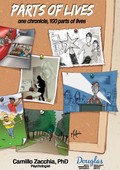Us versus Them…
From time to time you will notice how themes keep coming back again throughout my posts. That’s because I believe we are not very complicated creatures. We just appear so. In reality, human nature appears complex because there are an infinite number of combinations and permutations that can manifest themselves as a result of these few simple principles. One of the ones that affects many human interactions is the tendency to engage in Groupthink. This contributes to conflicts between countries, religions, sexes, and even sports teams.
I’ve written about this issue on a number of occasions including: The Fuel of Hatred, which I wrote on the fifth anniversary of the 9/11 attacks, Thanks! I Guess, which was written following Italy’s victory in the world cup of soccer, We’re All Immigrants, written during the reasonable accommodation debate in Quebec, and The Racism in All of Us, which which explores racism and segregation.
At the risk of repeating myself too often, I decided once again to write about the theme for my pre-Christmas column. It is easy to wish for Peace on Earth and Goodwill to Man but how exactly do we achieve that! Without understanding the microprocesses that contribute to segregation, racism, and conflict between peoples, we will be left scratching our heads.
I decided to tell a simple story about a personal experience I had as a graduate student. For the first time in my life, I lived in a place where racism was still omnipresent (much less than for the previous generation, but obvious nonetheless). What struck me was that I too was subject to it. It did not happen within the university context. Most of the students were from out of town anyway. But in interactions outside the university, I was often made to feel uncomfortable when interacting with African Americans.
I learned something important from these experiences; no matter who starts a conflict or where it comes from, once it is established, both sides are just as mean. This is actually very logical. If a group, let’s say Chinese people, were to treat me badly because I was Italian, and I would then discriminate against Chinese people and treat them badly, they would be right if they ever accused me of being against them! If we play that game, conflicts will never disappear.
I decided I would simply continue doing what came naturally. What I noticed was that the Us vs Them attitude quickly faded.
The less we interact with an identifiable group, the more they become seen as odd, or marginalized, or de-humanized. When this is the case, we treat them badly, and then they treat us badly and so on. Interaction and integration is the only way around this.
There is lots of evidence that integration works, and it works quickly. This is because we don’t have to change who we are. People are not very different from each other. All we have to do to see this is check our facts and assumptions by engaging in normal human interactions.
Big Mama in the rocker
(source: Big Mama dans sa chaise berçante. Journal Métro; December 16, 2008)
Segregation has a way of maintaining itself.
I lived for two years in Tallahassee, Florida. It wasn’t the Florida of beaches and palm trees that most of us think of, but part of the Deep South, only twenty miles from Georgia and forty from Alabama. By the early 1980’s, much had changed. Schools were integrated and race relations were light years ahead of what they were just one generation earlier. Still, there were significant pockets of segregation throughout the city.
I still remember driving through a “black” neighbourhood with my wife. On one occasion a group of children stuck their tongues out at us and yelled, “White trash!” Uncomfortable as we were made to feel, it would have been easy to perpetuate the segregation by avoiding this and similar areas. We chose not to.
Big Mama
I learned something interesting about the process of desegregation during my daily commute to the university. To get there, I would pass through a fence behind my apartment complex and ride my bike along a dead end street. Many of the small homes on the street were condemned or abandoned. On the veranda of one old house sat a big black woman in a rocking chair. Since the image was straight out of a movie, I named her “Big Mama.”
In Tallahassee, as in most small cities, it is customary to greet everyone you pass, whether on the street or in a building, with a, “Hi. How ya doin’?” In that tradition, I would always wave to Big Mama when I rode by. She never responded. I suppose desegregation hadn’t yet reached her street.
This continued for at least another half-dozen times. One day, I waved as usual and kept on riding. After I passed the next home, I heard in the background a feeble, “Hi,” from Big Mama. It was a start.
It took a few more passes but eventually the weak hellos became more and more enthusiastic. Soon, whenever she saw me approach, she would wave wildly and shout out, “How ya doin’?” sometimes even getting up from her chair!
A simple lesson
If we treat others as adversaries, they will act like adversaries. Whether it involves race relations, religious or cultural differences, or the marginalization of the mentally ill, segregation always perpetuates itself, with each side making the other one feel uncomfortable. The only way to overcome this is to ignore differences and face discomfort directly. The discriminated against will eventually come around. That’s what Big Mama taught me.
I think this isn’t a bad lesson to remember at this time of year. Happy Holidays!
Tagged as segregation, stigmatization, tolerance.
Posted in Anger and conflict, Human nature, Life.
Posted on 19 Dec 2008
